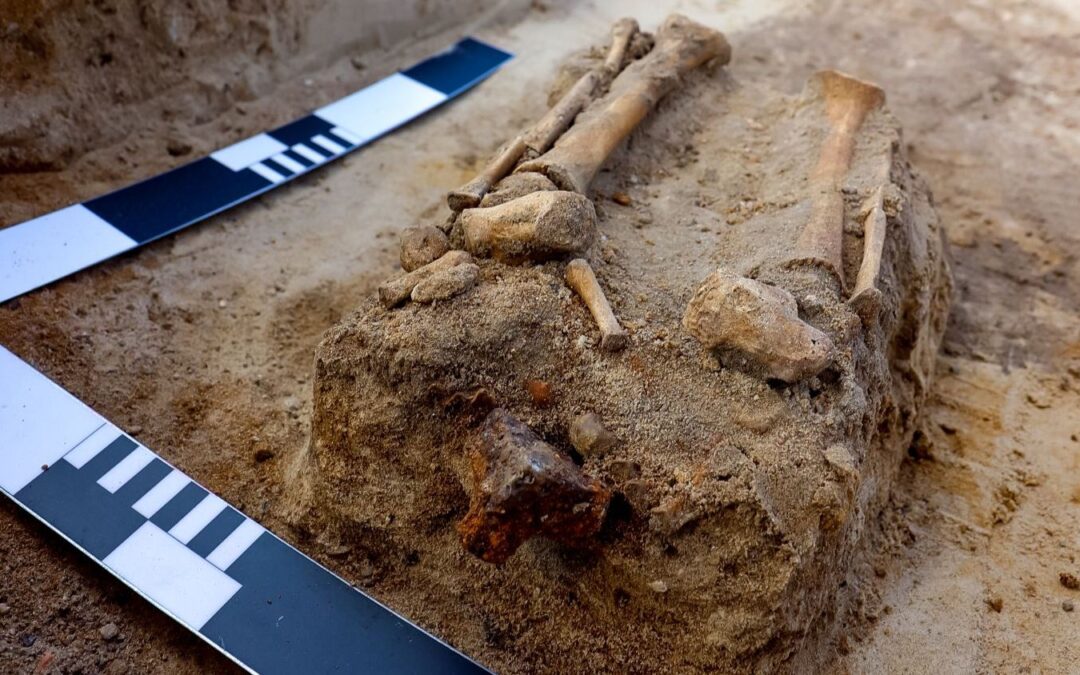The remains of a 17th-century child who was buried with what are believed to be “anti-vampire” precautions have been discovered at a cemetery in Poland that researchers believe was used for those excluded or feared by society. Last year, the remains of a woman buried with similar measures were discovered nearby.
Researchers from Nicolaus Copernicus University (UMK) in Toruń came across the child’s remains while excavating the 17th-century burial ground in the village of Pień, near the city of Bydgoszcz in north-central Poland.
The boy, aged between five and seven years, was discovered buried face down in a grave pit. According to a statement published by UMK, “this arrangement of the corpse may suggest that the deceased and his ‘activity’ after death were feared, for example that he would bite the living”.
“Turning the face down was supposed to make the deceased bite into the ground, so that they would no longer pose a threat to the local people,” added the researchers.
Only the lower half of the child’s skeleton has survived, under which archaeologists discovered a triangular padlock, which is also thought to have been a precaution to ensure that the suspected vampire would remain in the grave.
According to the university, analysis of the burial site’s layers shows that the grave “was disturbed and the rest of the corpse was taken,” with the possibility that they had been desecrated at some point.
The padlock buried with the child’s remains is similar to one found by researchers from UMK last year at a different grave two metres away. That was the resting place of a young woman who had been buried with a triangular padlock on the big toe on her left foot and a downwards-pointing sickle around her neck.
The padlock and the sickle are believed to have been placed on the woman’s body to “double protect” and prevent her from rising from the dead, said the researchers who discovered the remains. The woman drew international attention and was quickly dubbed a “vampire” by the media.
Archeologists discovered a 17th-century Polish 'vampire' with a sickle across her neck meant to prevent a return from the dead https://t.co/XBZFipqKVR
— Insider (@thisisinsider) September 4, 2022
“In the context of last year’s discovery, we wanted to check whether there were other similar burials nearby, which would be important for the interpretation of the function of the cemetery we studied,” said Dariusz Polinski, head of archaeological research at the site in Pień.
Polinski revealed that as well as the “vampiric” remains of the boy and woman, other unusual burial pits have been uncovered at the cemetery by his team.
These include what was described as a “puzzling cluster” of several children’s skeletons and the remains of a pregnant woman with a preserved fetus in her womb, buried in a hard, stony structure that Polinski believes would have been very difficult to dig.
Burials Unearthed in Poland Open the Casket on The Secret Lives of Vampires
Read more: https://t.co/wzjKJgUBzF #archaeology— Irish Archaeology (@irarchaeology) October 28, 2017
The unorthodox burial practices, as well as the lack of information about the site, has led Polinski and his team to speculate whether the cemetery was one especially allocated for those who had been excluded or feared by society at the time.
“There is no mention of it in written sources or on maps. This is typical of cemeteries, where people were buried in order to be excluded from a given community not only during life, but also after death,” he explained. “They were located away from buildings, outside city walls, at crossroads, on pastures and wastelands.”
“It seems that, due to the large number of atypical graves, with traces of strange practices, clearly indicating that the deceased was feared, we can assume that we are dealing with such a cemetery of the rejected here as well,” said Polinski.
A village in Poland has commemorated its long-lost Scottish community by restoring their former cemetery and launching an annual “Scottish Evening” featuring a bagpipe band.
In the 17th century, Poland was home to an estimated 30,000 Scots https://t.co/x9JyCyDm0Z
— Notes from Poland 🇵🇱 (@notesfrompoland) October 12, 2021

Notes from Poland is run by a small editorial team and published by an independent, non-profit foundation that is funded through donations from our readers. We cannot do what we do without your support.
Main image credit: Łukasz Czyżewski/UMK

Anna Hackett is an assistant editor at Notes from Poland. She is a recent graduate of European Studies from Trinity College Dublin and has had previous journalistic experience with the Irish Independent News & Media group.



















